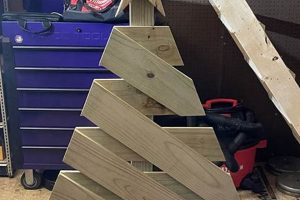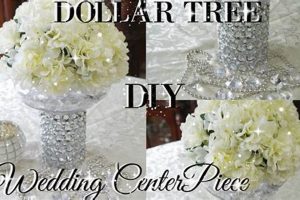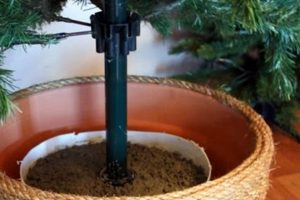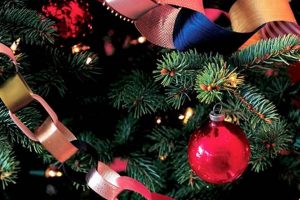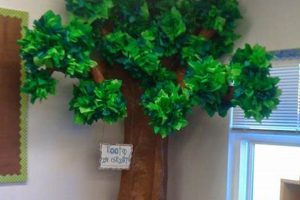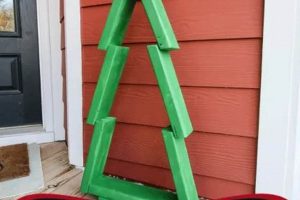A homemade Christmas tree represents an alternative to the traditional evergreen, often constructed from unconventional materials. These fabricated trees range from simple arrangements of branches in a vase to elaborate structures built from repurposed items, fulfilling the decorative purpose of a conventional Christmas tree. For example, a stack of books arranged in a conical shape and adorned with ornaments can serve as a substitute for a natural tree.
Creating personalized holiday decorations offers multiple advantages. It allows for creative expression, adapting to individual preferences and available resources. This approach can be more sustainable by utilizing recycled materials and reducing the demand for commercially produced trees. Historically, alternative Christmas trees have emerged during periods of resource scarcity or as a rejection of traditional norms, reflecting evolving cultural values.
The subsequent sections will explore various design approaches, materials commonly employed in their creation, and considerations for ensuring the stability and safety of these festive constructions. Furthermore, the environmental implications and cost-effectiveness associated with this practice will be examined.
DIY Xmas Tree
Constructing a fabricated holiday tree requires careful planning and execution. These tips provide guidance to ensure a successful and visually appealing result.
Tip 1: Material Selection: Opt for durable and lightweight materials. Reclaimed wood, sturdy cardboard, or even metal frames provide a solid foundation without excessive weight. Consider the overall aesthetic and choose materials that complement the desired style.
Tip 2: Structural Integrity: Prioritize stability during construction. Ensure a wide base to prevent tipping, especially for taller structures. Use strong adhesives or fasteners appropriate for the selected materials. Reinforce weak points with additional supports.
Tip 3: Scalability and Proportion: Plan the size and dimensions of the tree based on the available space. Maintain a sense of proportion to ensure visual harmony. Avoid overcrowding smaller spaces with overly large structures.
Tip 4: Illumination Considerations: Integrate lighting strategically. LED lights are energy-efficient and produce minimal heat. Secure the lights to the structure to prevent them from dangling or creating fire hazards. Conceal wiring whenever possible for a cleaner appearance.
Tip 5: Ornament Attachment: Implement a secure and non-damaging system for attaching ornaments. Use lightweight ornaments to minimize stress on the structure. Employ hooks, clips, or wire ties that blend seamlessly with the overall design.
Tip 6: Color Palette and Theme: Establish a clear color palette and theme to guide the design process. Consistent use of color and thematic elements creates a cohesive and visually pleasing result. Restraint is often more effective than excessive ornamentation.
Tip 7: Safety Precautions: Prioritize safety throughout the construction process. Wear appropriate protective gear, such as gloves and eye protection, when working with tools and materials. Ensure adequate ventilation when using adhesives or paints.
Implementing these guidelines will contribute to the creation of a structurally sound, aesthetically pleasing, and safe fabricated holiday tree. The benefits include reduced environmental impact, cost savings, and a personalized decorative element.
The following section will delve into creative design ideas and inspiration for crafting unique holiday trees.
1. Material Choice
Material choice is a foundational aspect of creating a homemade Christmas tree. It directly impacts the structural integrity, aesthetic appeal, and overall sustainability of the final product. The selection process must consider factors beyond mere visual preference, encompassing structural requirements, cost implications, and environmental impact.
- Structural Integrity and Load Bearing
The chosen materials must possess sufficient strength to support their weight and any added ornaments. Materials like metal, sturdy wood, or reinforced cardboard are appropriate for larger, heavier structures. Conversely, lighter materials such as paper or fabric are better suited for smaller, less demanding designs. Failure to consider load-bearing capacity can result in structural collapse, rendering the tree unusable or even hazardous.
- Aesthetic and Thematic Consistency
Materials should align with the desired aesthetic and theme. Rustic themes benefit from natural materials like wood, branches, or burlap. Modern designs may utilize sleek metal, glass, or synthetic polymers. Inconsistency in material choices can detract from the overall visual coherence, undermining the intended artistic effect.
- Cost-Effectiveness and Accessibility
Materials should be selected based on budget constraints and ease of acquisition. Repurposing existing materials, such as reclaimed wood, recycled paper, or discarded plastic, can significantly reduce costs. Accessibility is also a key factor; readily available materials simplify the construction process and minimize logistical challenges.
- Environmental Impact and Sustainability
Prioritizing sustainable materials reduces the environmental footprint. Using recycled or upcycled materials minimizes waste and conserves resources. Choosing biodegradable or compostable options for smaller components, such as ornament hangers, further enhances sustainability. Conversely, utilizing non-recyclable or environmentally harmful materials negates the potential environmental benefits of a homemade tree.
The interplay of these facets underscores the critical role of thoughtful material selection. By carefully considering structural needs, aesthetic goals, cost limitations, and environmental concerns, creators can design and build homemade holiday trees that are not only visually appealing but also structurally sound, economically viable, and environmentally responsible.
2. Structural Design
Structural design is paramount in the creation of a durable and visually appealing alternative Christmas tree. It dictates the stability, load-bearing capacity, and overall form of the constructed object, ensuring it can fulfill its decorative purpose safely and effectively.
- Base Stability and Support
The base is the foundation of any fabricated tree. It must provide adequate support to prevent tipping or collapse, especially for taller or heavier designs. Options include a wide circular base constructed from wood, a weighted metal stand, or a reinforced cardboard platform. Insufficient base stability undermines the entire structure, posing a safety risk and detracting from the aesthetic appeal. For example, a tall tree built on a narrow, lightweight base is prone to toppling, especially when adorned with ornaments.
- Framework Construction and Load Distribution
The framework distributes the weight of the tree and its ornaments evenly. It may consist of a central pole with radiating branches, a stacked arrangement of progressively smaller shapes, or an interconnected network of geometric forms. The framework must be constructed from materials capable of withstanding the intended load. Uneven load distribution can lead to localized stress points, causing structural failure. For instance, a cardboard tree with branches attached only at the tips is likely to buckle under the weight of ornaments.
- Material Compatibility and Joint Integrity
The chosen materials must be compatible in terms of strength, flexibility, and bonding properties. Joints must be securely fastened using appropriate adhesives, fasteners, or welding techniques. Incompatible materials or poorly constructed joints compromise the structural integrity, increasing the risk of separation or collapse. For example, gluing heavy wooden branches to a lightweight paper structure is unlikely to result in a durable connection.
- Aerodynamic Considerations and Wind Resistance
For trees intended for outdoor display, aerodynamic considerations are crucial. The design should minimize wind resistance to prevent tipping or damage from gusts. Options include a streamlined shape, a weighted base, or anchoring the tree to the ground. Failure to account for wind resistance can result in the tree being blown over or damaged in inclement weather. A tall, broad structure is more susceptible to wind forces than a smaller, more compact design.
These facets of structural design, from base stability to aerodynamic considerations, are integral to the success of alternative Christmas tree construction. Careful attention to these details ensures a safe, stable, and visually pleasing decorative element that can be enjoyed throughout the holiday season.
3. Space Optimization
In the context of fabricated holiday trees, space optimization refers to the strategic adaptation of design to suit limited spatial environments. This approach prioritizes efficient use of available area without sacrificing aesthetic appeal or festive functionality. The following facets detail practical methods of achieving space optimization.
- Vertical Construction
Vertical construction maximizes upward space, minimizing the tree’s footprint. This involves designing tall, slender structures that extend upwards rather than outwards. Examples include cone-shaped trees constructed from stacked books or tiered shelves adorned with holiday decorations. This approach is particularly suitable for apartments or small living rooms where floor space is at a premium. Implications include the ability to incorporate a festive element without significantly impacting room functionality.
- Wall-Mounted Designs
Wall-mounted trees completely eliminate the need for floor space. These designs are affixed directly to the wall, creating a two-dimensional representation of a traditional tree. Examples include trees constructed from reclaimed wood arranged in a tree shape, or garlands and lights hung to mimic a tree silhouette. Wall-mounted designs are ideal for extremely small spaces or areas where a floor-standing tree would be impractical. This approach allows for holiday decoration without impeding traffic flow or occupying valuable floor space.
- Corner Placement Adaptation
Corner placement adapts the tree’s form to fit snugly within a corner, utilizing otherwise underutilized space. This often involves creating a quarter-tree design or modifying a traditional tree to have a flattened back. Examples include a traditional evergreen trimmed to fit into a corner, or a fabricated tree with a triangular footprint. This approach maximizes the use of corner space, allowing for a larger tree within a limited area. The adaptation minimizes intrusion into the main living space.
- Collapsible or Modular Designs
Collapsible or modular trees can be easily disassembled and stored when not in use, minimizing storage space requirements. These designs typically consist of interlocking pieces or folding sections that can be quickly assembled and disassembled. Examples include trees constructed from interlocking cardboard pieces, or trees with hinged branches that fold flat. This approach is particularly useful for individuals with limited storage space or those who only display a tree during the immediate holiday season. The design minimizes the year-round space impact.
Collectively, these space optimization strategies provide practical solutions for incorporating a festive tree into limited environments. By strategically adapting the tree’s design to suit the available space, individuals can enjoy the holiday spirit without compromising functionality or creating clutter. The application of these principles allows for the integration of decorative elements into even the smallest of living spaces.
4. Personalization
Personalization, in the context of homemade holiday trees, transcends mere decoration. It represents a deliberate infusion of individual identity, values, and aesthetic preferences into a symbol of tradition, resulting in a uniquely meaningful festive element.
- Reflecting Individual Aesthetic Preferences
The choice of materials, color palettes, and decorative elements allows for the expression of individual style. A minimalist may opt for a sparsely adorned tree constructed from reclaimed wood, while an individual with eclectic tastes might create a vibrant, multi-textured tree incorporating repurposed materials. This facet enables the creation of a visual representation of personal aesthetic values within the holiday setting. For example, an artist might showcase their work by incorporating miniature paintings or sculptures into the tree’s design.
- Celebrating Personal History and Memories
The inclusion of sentimental items, such as family heirlooms, handmade ornaments, or travel souvenirs, transforms the tree into a repository of personal history. Each item serves as a tangible reminder of past experiences and strengthens emotional connections. This approach fosters a sense of nostalgia and continuity, linking the present celebration to past events. An example includes incorporating ornaments passed down through generations, each carrying its own unique story and significance.
- Expressing Values and Beliefs
The tree can be used to communicate personal values, such as environmental consciousness or social awareness. Using recycled materials, incorporating symbols of peace or unity, or supporting local artisans through the purchase of handmade ornaments allows for the expression of individual beliefs. This approach elevates the tree beyond a purely decorative object, transforming it into a statement of personal values. For instance, constructing a tree entirely from reclaimed materials demonstrates a commitment to sustainability.
- Adapting to Individual Needs and Constraints
Personalization extends to adapting the tree’s design to suit individual needs and constraints, such as limited space or budgetary restrictions. A small apartment dweller might opt for a wall-mounted tree constructed from fabric scraps, while an individual on a tight budget might repurpose everyday items into creative ornaments. This adaptation ensures that the holiday spirit can be embraced regardless of individual circumstances. For example, using pinecones collected from a local park as ornaments provides an inexpensive and nature-inspired decorative element.
These facets of personalization collectively transform the homemade holiday tree from a generic festive symbol into a deeply personal expression of identity, history, values, and individual circumstances. The result is a unique and meaningful decorative element that resonates with personal significance, enriching the holiday experience.
5. Cost Savings
The construction of a homemade Christmas tree often presents a demonstrable reduction in expenditure compared to the purchase of a commercially produced tree. This cost-effectiveness arises from several factors, including the utilization of repurposed materials, the elimination of retail markups, and the reduction of associated transportation expenses. For example, a tree constructed from reclaimed wood requires minimal initial investment, contrasting sharply with the purchase price of a new, natural or artificial tree. The impact is a direct reduction in holiday expenses, potentially freeing up resources for other budgetary allocations.
Furthermore, the practice of crafting a fabricated tree mitigates recurring costs associated with traditional alternatives. A natural tree necessitates annual purchase, while even an artificial tree may require eventual replacement. By contrast, a well-constructed homemade tree, utilizing durable materials, can provide years of service, further amplifying long-term cost savings. Consider a family that annually spends $100 on a natural tree; over a decade, this amounts to $1000. A single investment in materials for a durable, homemade alternative could represent a substantial saving over the same period. The implementation of cost-effective methods has practical implications for budgetary planning.
In summary, the creation of a homemade Christmas tree offers a tangible opportunity to reduce holiday spending. The benefits extend beyond the immediate cost savings, encompassing long-term financial advantages and resource management. While the initial effort of construction is required, the resulting reduction in expenditure and the personalized nature of the fabricated tree represent a compelling alternative to commercially available options. Challenges might involve initial material sourcing or the time investment required for construction, but the financial advantages often outweigh these considerations.
DIY Xmas Tree
The following addresses common inquiries regarding the design, construction, and implications of constructing alternative holiday trees.
Question 1: What materials are most suitable for a durable and stable homemade Christmas tree?
Durable options include reclaimed wood, sturdy cardboard, and metal frames. Lightweight materials are recommended to minimize stress on the structure. Material selection should align with the intended aesthetic and structural requirements.
Question 2: How can the risk of a homemade Christmas tree tipping over be minimized?
A wide, stable base is essential. Distribute weight evenly throughout the structure. Consider adding weights to the base for increased stability, particularly for taller designs. Securing the tree to a wall or other stable surface may be necessary in some cases.
Question 3: What fire safety precautions should be observed when incorporating lights into a fabricated Christmas tree?
Use LED lights, as they generate minimal heat. Ensure that all wiring is in good condition and properly insulated. Avoid overloading electrical circuits. Never leave illuminated trees unattended. Consider incorporating a timer for automatic shut-off.
Question 4: How does the cost of a homemade Christmas tree compare to a commercially purchased tree?
The cost varies depending on the materials used. Repurposed materials can significantly reduce expenses. Over time, a durable homemade tree is often more cost-effective than purchasing a new tree each year.
Question 5: What are the environmental implications of creating a DIY Christmas tree?
Using recycled or upcycled materials reduces waste and minimizes environmental impact. Choosing sustainable materials further enhances the environmental benefits. A homemade tree avoids the environmental costs associated with transporting and disposing of commercially produced trees.
Question 6: How can a fabricated Christmas tree be adapted to suit a small living space?
Consider wall-mounted designs, vertical construction, or corner placement. Collapsible or modular trees offer easy storage when not in use. Adapt the size and shape of the tree to maximize available space.
These answers provide a foundation for understanding the key considerations involved in creating personalized holiday trees. Addressing these factors contributes to a safer, more sustainable, and cost-effective holiday celebration.
The subsequent section explores inspirational design ideas and innovative approaches to constructing unique holiday trees.
DIY Xmas Tree
This exploration has illuminated the multifaceted aspects of diy xmas tree construction. From material selection and structural design to space optimization, personalization, and cost savings, each facet presents unique opportunities and challenges. The successful creation of a fabricated holiday tree requires a synthesis of these elements, resulting in a decorative object that is both visually appealing and functionally sound.
The future of holiday decoration may increasingly embrace sustainable and personalized alternatives to traditional practices. The diy xmas tree exemplifies this trend, offering a pathway to both environmental responsibility and creative expression. Further innovation in design and material usage will likely expand the possibilities for crafting unique and meaningful holiday decorations.


